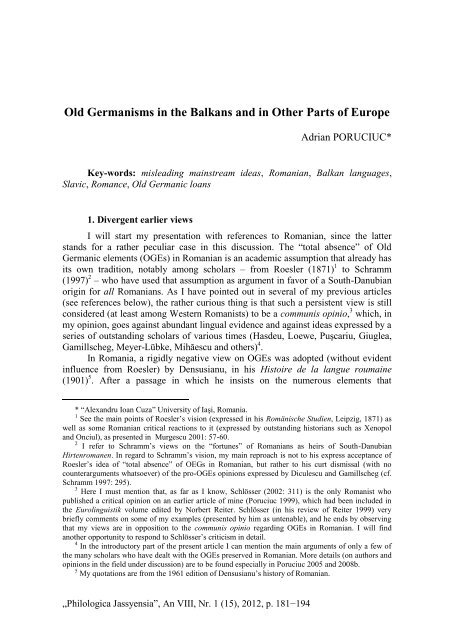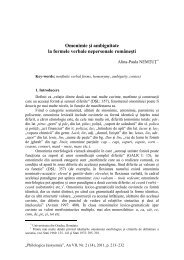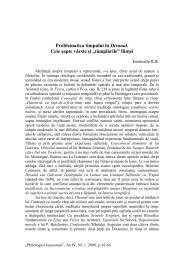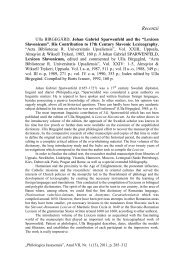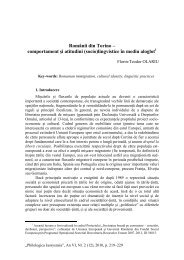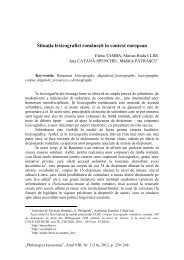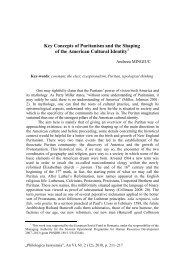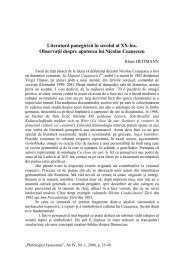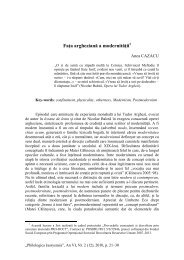O sutÄ de ani de cartografie lingvisticÄ româneascÄ - Philologica ...
O sutÄ de ani de cartografie lingvisticÄ româneascÄ - Philologica ...
O sutÄ de ani de cartografie lingvisticÄ româneascÄ - Philologica ...
Create successful ePaper yourself
Turn your PDF publications into a flip-book with our unique Google optimized e-Paper software.
Old Germ<strong>ani</strong>sms in the Balkans and in Other Parts of Europe<br />
Adrian PORUCIUC*<br />
Key-words: misleading mainstream i<strong>de</strong>as, Rom<strong>ani</strong>an, Balkan languages,<br />
Slavic, Romance, Old Germ<strong>ani</strong>c loans<br />
1. Divergent earlier views<br />
I will start my presentation with references to Rom<strong>ani</strong>an, since the latter<br />
stands for a rather peculiar case in this discussion. The “total absence” of Old<br />
Germ<strong>ani</strong>c elements (OGEs) in Rom<strong>ani</strong>an is an aca<strong>de</strong>mic assumption that already has<br />
its own tradition, notably among scholars – from Roesler (1871) 1 to Schramm<br />
(1997) 2 – who have used that assumption as argument in favor of a South-Danubian<br />
origin for all Rom<strong>ani</strong>ans. As I have pointed out in several of my previous articles<br />
(see references below), the rather curious thing is that such a persistent view is still<br />
consi<strong>de</strong>red (at least among Western Rom<strong>ani</strong>sts) to be a communis opinio, 3 which, in<br />
my opinion, goes against abundant lingual evi<strong>de</strong>nce and against i<strong>de</strong>as expressed by a<br />
series of outstanding scholars of various times (Has<strong>de</strong>u, Loewe, Puşcariu, Giuglea,<br />
Gamillscheg, Meyer-Lübke, Mihăescu and others) 4 .<br />
In Rom<strong>ani</strong>a, a rigidly negative view on OGEs was adopted (without evi<strong>de</strong>nt<br />
influence from Roesler) by Densusianu, in his Histoire <strong>de</strong> la langue roumaine<br />
(1901) 5 . After a passage in which he insists on the numerous elements that<br />
* “Alexandru Ioan Cuza” University of Iaşi, Rom<strong>ani</strong>a.<br />
1 See the main points of Roesler’s vision (expressed in his Romänische Studien, Leipzig, 1871) as<br />
well as some Rom<strong>ani</strong>an critical reactions to it (expressed by outstanding historians such as Xenopol<br />
and Onciul), as presented in Murgescu 2001: 57-60.<br />
2 I refer to Schramm’s views on the “fortunes” of Rom<strong>ani</strong>ans as heirs of South-Danubian<br />
Hirtenromanen. In regard to Schramm’s vision, my main reproach is not to his express acceptance of<br />
Roesler’s i<strong>de</strong>a of “total absence” of OEGs in Rom<strong>ani</strong>an, but rather to his curt dismissal (with no<br />
counterarguments whatsoever) of the pro-OGEs opinions expressed by Diculescu and Gamillscheg (cf.<br />
Schramm 1997: 295).<br />
3 Here I must mention that, as far as I know, Schlösser (2002: 311) is the only Rom<strong>ani</strong>st who<br />
published a critical opinion on an earlier article of mine (Poruciuc 1999), which had been inclu<strong>de</strong>d in<br />
the Eurolinguistik volume edited by Norbert Reiter. Schlösser (in his review of Reiter 1999) very<br />
briefly comments on some of my examples (presented by him as untenable), and he ends by observing<br />
that my views are in opposition to the communis opinio regarding OGEs in Rom<strong>ani</strong>an. I will find<br />
another opportunity to respond to Schlösser’s criticism in <strong>de</strong>tail.<br />
4 In the introductory part of the present article I can mention the main arguments of only a few of<br />
the many scholars who have <strong>de</strong>alt with the OGEs preserved in Rom<strong>ani</strong>an. More <strong>de</strong>tails (on authors and<br />
opinions in the field un<strong>de</strong>r discussion) are to be found especially in Poruciuc 2005 and 2008b.<br />
5 My quotations are from the 1961 edition of Densusianu’s history of Rom<strong>ani</strong>an.<br />
„<strong>Philologica</strong> Jassyensia”, An VIII, Nr. 1 (15), 2012, p. 181−194
Adrian PORUCIUC<br />
Rom<strong>ani</strong>an has in common with the Romance dialects of northern Italy and of the<br />
Alps, Densusianu continues as follows (1961: 157):<br />
There is, however, one aspect which makes the Rom<strong>ani</strong>an language get totally<br />
away from Italian and Rhetic and which remains to be clarified. As it has often been<br />
observed, there are no Old Germ<strong>ani</strong>c elements in Rom<strong>ani</strong>an, and it is due to that<br />
feature that Rom<strong>ani</strong>an has a singular position within the Romance family of<br />
languages 6 .<br />
Densusianu goes on (loc.cit.) by assuming that the early interruption of direct<br />
contacts between Italian and Rom<strong>ani</strong>an prevented OGEs that had been borrowed<br />
into Italian (mainly during the 5 th -6 th centuries) from reaching Rom<strong>ani</strong>an too (as if<br />
Rom<strong>ani</strong>an could get OGEs mainly via Italian!). As for the possible effects of direct<br />
(historically attested) contacts between Old Germ<strong>ani</strong>c populations and the natives<br />
of Southeast Europe, Densusianu consi<strong>de</strong>rs that Goths and Gepids simply „did not<br />
get into very close contact with the Roman population,” such a situation accounting<br />
for „the complete absence of Old Germ<strong>ani</strong>c elements in Rom<strong>ani</strong>an” (loc.cit.) 7 .<br />
After Densusianu’s time, whereas representatives of the Cluj school or<br />
philology, notably Puşcariu 8 and Giuglea, 9 pointed out cases of Rom<strong>ani</strong>an words<br />
that could be best explained as Old Germ<strong>ani</strong>sms, 10 important representatives of the<br />
schools of Bucharest (Rosetti) 11 and Iasi (Arvinte) 12 perpetuated an attitu<strong>de</strong> of<br />
extreme skepticism in regard to OGEs, such an attitu<strong>de</strong> actually being in keeping<br />
with a general one among European Rom<strong>ani</strong>sts. Here I do not refer to a certain neo-<br />
Roeslerian hard line (as represented by Schramm’s vision – see above), but rather to<br />
a peculiar reluctance to accept propositions of OGEs in Romance languages, as<br />
6 In the present article, all translations from Rom<strong>ani</strong>an and other languages into English are mine.<br />
7 The fact that Densusianu’s vision remained influential for quite a long time is visible in<br />
Ciorănescu’s rejection of previous propositions of Old Germ<strong>ani</strong>sms in Rom<strong>ani</strong>an (see, for instance the<br />
entries bor<strong>de</strong>i and fară in Ciorănescu’s the etymological dictionary, ed. 2001).<br />
8 I ma<strong>de</strong> use of Puşcariu’s Limba română, ed. 1976. Puşcariu takes into consi<strong>de</strong>ration (1976: 269)<br />
Old Germ<strong>ani</strong>c populations – Marcomanni, Goths, Gepids, Vandals and Langobards – that played<br />
significant military-political roles in Dacia “beginning with the second century of our time.” In a<br />
noteworthy statement, Puşcariu (loc.cit.) consi<strong>de</strong>rs that “it would not be surprising at all, if the direct<br />
contacts between our ancestors and Old Germ<strong>ani</strong>c populations should have left, in our language, traces<br />
like the ones recor<strong>de</strong>d in Dalmatia […]”.<br />
9 Giuglea is worth mentioning here mainly for his methodological statements that reflect his strong<br />
belief in the existence of OGEs in Rom<strong>ani</strong>an. In a special paper (first published in 1922, then<br />
republished in Giuglea1983: 91), Giuglea brings credible arguments in favor of the following i<strong>de</strong>a:<br />
“The earlier belief that an Old Germ<strong>ani</strong>c influence is to be exclu<strong>de</strong>d in the case of Rom<strong>ani</strong>an now<br />
appears to be a matter of wrong principle […]”.<br />
10 Significantly, although Meyer-Lübke, like many other outstanding Rom<strong>ani</strong>sts, appears to be<br />
quite cautious about the very i<strong>de</strong>a of OEGs in Rom<strong>ani</strong>an, in his REW he inclu<strong>de</strong>s (without any<br />
criticism) several of the Old Germ<strong>ani</strong>sms propoun<strong>de</strong>d by Puşcariu (rum. râncaciu ‘halbkastriert’ – s.v.<br />
7044. rank; rum. rapăn ‘Räu<strong>de</strong>’, rapură ‘eine Fußkrankheit’ – s.v. 7059. rappe ‘Grind’) and by<br />
Giuglea (rum. strungă ‘Melkhür<strong>de</strong>’ – s.v. stanga ‘Stange’; rum. stinghe ‘dünne Stange’ – s.v. *stingils<br />
‘Stengel’; rum. tapă ‘Spund’ – s.v. tappa ‘Spund’, ‘Zapfen’). In regard to Meyer-Lübke’s vision of<br />
OEGs, see also Poruciuc 2009b.<br />
11 See especially the minute presentation of quite many opinions (on the issue of OGRs in<br />
Rom<strong>ani</strong>an) in the chapter “Germ<strong>ani</strong>ca” inclu<strong>de</strong>d in Rosetti’s Istoria limbii române (1986: 220−224).<br />
12 Arvinte’s many doubts about the issue of OGRs in Rom<strong>ani</strong>an are m<strong>ani</strong>fest in his volume of 2002<br />
(see especially pages 9−10).<br />
182
Old Germ<strong>ani</strong>sms in the Balkans and in Other Parts of Europe<br />
visible, for instance, in a bird’s-eye-view article by Meier (1977), or in certain<br />
subchapters of Tagliavini’s synthetic volume on Romance languages (1977 – see<br />
also below). In a special passage, Gamillscheg (1935: 247) directly – and rather<br />
harshly – refers to the reason why “the Rom<strong>ani</strong>st” either overlooks or rejects the<br />
very i<strong>de</strong>a of OEGs in Rom<strong>ani</strong>an:<br />
Daß diese germ<strong>ani</strong>sche Lehnwörter <strong>de</strong>s Ostrom<strong>ani</strong>schen nicht schon früher<br />
festgestellt wor<strong>de</strong>n sind, erklärt sich daraus, daß die etymologische Forschung auf<br />
<strong>de</strong>m Gebiete <strong>de</strong>s Rumänischen, in <strong>de</strong>m neben <strong>de</strong>n vorlateinischen und lateinischen<br />
Elementen Lehnwörter aus <strong>de</strong>n verschie<strong>de</strong>nsten Sprachen eingedrungen sind […], so<br />
weitgehen<strong>de</strong> Kenntnisse verlangt, wie sie <strong>de</strong>r Rom<strong>ani</strong>st im Allgemeinen nicht besitzt.<br />
2. The fara lexical family and its problems<br />
To return to Rosetti, as major representative of a peculiar Rom<strong>ani</strong>an<br />
skepticism in regard to OGEs (1986: 220), several of his objections to opinions of<br />
earlier specialists are worthy of consi<strong>de</strong>ration – see especially his insistence on<br />
necessary observance of “phonetic chronology” and on grouping of Old Germ<strong>ani</strong>c<br />
loans in keeping with “precise features of civilization”. Also, in a special passage<br />
that I will ren<strong>de</strong>r in translation, Rosetti provi<strong>de</strong>s a constructive general perspective<br />
that <strong>de</strong>serves all attention:<br />
The settling down of Germ<strong>ani</strong>c populations north of the Danube and their<br />
living si<strong>de</strong> by si<strong>de</strong> with local Rom<strong>ani</strong>zed populations are […] well established<br />
facts. Therefore, Rom<strong>ani</strong>zed populations north of the Danube may very well have<br />
borrowed words from Germ<strong>ani</strong>c populations in Dacia. But we must also admit<br />
that such words could be borrowed, at the same time, by other populations in the<br />
northern part of the Balkan Peninsula. Methodologically, we may therefore<br />
expect that Germ<strong>ani</strong>c terms should not be <strong>de</strong>tected in Rom<strong>ani</strong>an only.<br />
In connection with the methodological line suggested by Rosetti, I consi<strong>de</strong>r<br />
that nothing can be more evi<strong>de</strong>ntly Germ<strong>ani</strong>c-based and, at the same time, more<br />
divergently interpreted than the series of loans based on the Old Germ<strong>ani</strong>c term fara.<br />
I have already published an article, in Rom<strong>ani</strong>an, on the main etymological aspects<br />
implied by the fara lexical family (Poruciuc 2009a); here I will make only a concise<br />
review of the main arguments I used in that article (plus some supplementary items).<br />
In his presentation of the Langobard conquest of Northern Italy (AD 568),<br />
Paulus Diaconus 13 mentions a <strong>de</strong>mand expressed by Gisulf (a close relative of King<br />
Alboin) when the king asked him to become the ruler of Forum Iulii:<br />
But Gisulf answered that he would not accept to rule that city and its<br />
inhabitants, unless he was first granted the Langobard faras – that is, clans or sibs – of<br />
his own choice 14 .<br />
The Old Germ<strong>ani</strong>c faras, as specific associations of people on the move, are<br />
quite well known to historians who have <strong>de</strong>alt with the period of Völkerwan<strong>de</strong>rungen:<br />
in speaking of the passage from earlier Germ<strong>ani</strong>c clan-like<br />
13 I ma<strong>de</strong> use of the 2011 bilingual (Latin-Rom<strong>ani</strong>an) edition of Paulus Diaconus’s history of the<br />
Langobards.<br />
14 In the original: Qui Gisulf non prius se regimen eius<strong>de</strong>m civitatis et populi suscepturum edixit,<br />
nisi ei quas ipse eligere voluisset Langobardorum faras, hoc est generationes vel lineas, tribueret.<br />
183
Adrian PORUCIUC<br />
communities (Abstammungsgemeinschaften) to interest-associations (Interessengemeinschaften),<br />
Wolfram (1995: 69) presents the latter as being of the kind best<br />
represented by the Langobard fara, interpreted as Fahrtgemeinschaft; and, in his<br />
turn, Rosen (2006: 94) interprets the Langobard farae as Fahrtverbän<strong>de</strong>.<br />
No Germ<strong>ani</strong>st would find reasons to doubt the etymological connection<br />
between Langobard fara and the Old Germ<strong>ani</strong>c verb faran (cf. German fahren,<br />
English fare). In that respect, I could suggest only a correction of the *fara entry in<br />
Köbler’s dictionary of Gothic (1989). Köbler consi<strong>de</strong>rs that Gothic fara – which<br />
occurs in onomastic compounds such as Sen<strong>de</strong>fara Thurdifara, Wilifara – meant<br />
‘journey’ as well as ‘female driver’ (!). In my opinion the three compounds quite<br />
clearly indicate (1) that the -fara component indicated (at least originally) the<br />
belonging of the name-bearer to a certain Fahrtgemeinschaft, and (2) that fara, as<br />
<strong>de</strong>signation of a peculiar Old Germ<strong>ani</strong>c type of community, was not used<br />
exclusively by the Langobards, but also by other Old Germ<strong>ani</strong>c populations, such as<br />
the Goths of the sixth century (when the three above-mentioned names were<br />
recor<strong>de</strong>d). If the origin and the historical-linguistic implications of fara are clear<br />
enough on Germ<strong>ani</strong>c soil, not the same thing can be said about fara as borrowed into<br />
non-Germ<strong>ani</strong>c languages.<br />
Sufficiently clear is the situation of fara (as loan) in Italian, due not only to<br />
the precious attestation in Paulus Diaconus’s Historia Langobardorum 15 , but also to<br />
other clues about the way in which the term fara (which originally <strong>de</strong>signated family<br />
associations of the Langobards who settled, as Herrenvolk, in various North-Central<br />
Italian regions) shifted to the me<strong>ani</strong>ng of ‘piece of land (occupied by a Langobard<br />
kin-based association)’. The material given un<strong>de</strong>r fara in the Battisti/ Alessio<br />
dictionary of Italian (ed. 1950-1957) indicates that the me<strong>ani</strong>ng of the term in the 9 th<br />
century still was “gruppo famigliare di origine barbarica” and that Fara occurred in<br />
a series of place names in northern and central Italy. An outstanding Rom<strong>ani</strong>st,<br />
Tagliavini (1977: 231−232 – with my brackets) presents the fortune of Langobard<br />
fara as follows:<br />
The Langobard state was conceived […] as a union of all free men able to go<br />
to war […]; it was a military state, but the military org<strong>ani</strong>zation was based on a series<br />
of groupings of families or farae […]. Besi<strong>de</strong>s military functions, the chiefs of such<br />
farae also had juridical and civil functions […]. This term [fara], whose etymon is<br />
being strongly <strong>de</strong>bated, frequently occurs in place names, together with genitive<br />
forms of personal names: Fara A<strong>de</strong>mari, Fara Authari etc. [which should be referred<br />
to the Gothic Sen<strong>de</strong>fara Thurdifara and Wilifara given above]. The Italian toponyms<br />
that contain fara very clearly ouline the area occupied by the Langobards […]. But it<br />
is exactly the wi<strong>de</strong>r extension to the south that allows us to explain the presence of<br />
continuators of fara – not as a toponym, but as an appellative – in Neo-Greek (φάρα),<br />
in Alb<strong>ani</strong>an (far(r)ë) and in Arom<strong>ani</strong>an, with its original me<strong>ani</strong>ng of ‘kin’ […].<br />
I really do not see why the etymology of fara should be “strongly <strong>de</strong>bated” 16 .<br />
Tagliavini’s presentation is quite credible as long as it refers to the evolution of fara<br />
15 In fact, much earlier than Paulus Diaconus, the one who first mentioned fara on Italian soil was<br />
sixth-century Marius Aventinus (cf. Battisti/ Alessio dictionary, ed. 1950-1957, s.v. fara).<br />
16 Among other things, the Old Germ<strong>ani</strong>c origin of both Italian fara and Alb<strong>ani</strong>an farë is so clear,<br />
that the attempts of some linguists to clarify the etymology of Alb<strong>ani</strong>an farë ‘seed, clan’ by resorting<br />
184
Old Germ<strong>ani</strong>sms in the Balkans and in Other Parts of Europe<br />
in Italy; but it becomes hardly credible in the end, when he suggests not only that<br />
fara moved from Italy to the Balkans, but also that, in migrating to the Balkans, fara<br />
somehow returned to its original Old Germ<strong>ani</strong>c me<strong>ani</strong>ng. However, in regard to the<br />
<strong>de</strong>bate on fara, the most confusing conclusions have been drawn not by Tagliavini,<br />
but by specialists who have <strong>de</strong>alt with Balkan languages.<br />
Before referring to Alb<strong>ani</strong>an farë (‘seed, clan’) as probably inherited from<br />
Proto-Indo-European, Huld (1983: 63) mentions that Gustav Meyer “hesitatingly<br />
suggested that this word and Bulgarian fara ‘race’ may come from Germ<strong>ani</strong>c.” True<br />
enough, the author of the first etymological dictionary of Alb<strong>ani</strong>an, Gustav Meyer<br />
(1891, s.v. farε ‘Stamm, Geschlecht, Art, Nachkommenschaft, Same, Frucht’) 17<br />
cautiously mentions the possibility of a Germ<strong>ani</strong>c origin for Alb<strong>ani</strong>an farë („Man<br />
hält das Wort für ein germ<strong>ani</strong>sches“). Meyer also refers the Alb<strong>ani</strong>an word to<br />
Langobard fara (‘Nachkommenschaft, Familie, Geschlecht’), to North Italian fara<br />
(‘kleines Landgut’), as well as to three Balkan terms, namely Bulgarian fara, Neo-<br />
Greek φάρα 18 and “Macedo-Rom<strong>ani</strong>an” (Arom<strong>ani</strong>an) fară, without any mention of<br />
the existence of fară in dialectal Daco-Rom<strong>ani</strong>an too.<br />
Papahagi (1974, s.v. fară “neam, trib”) simply refers Arom<strong>ani</strong>an fară to Neo-<br />
Greek φάρα, Alb<strong>ani</strong>an farë, and Daco-Rom<strong>ani</strong>an fară (without further comments).<br />
But things are quite complicated as regards etymological interpretations of the<br />
Daco-Rom<strong>ani</strong>an term. Rather radically, Rosetti (1976: 255) – in joining Weigand’s<br />
influential views – inclu<strong>de</strong>s fară (‘Geschlecht’) among “the few Transylv<strong>ani</strong>an<br />
dialectal terms that may be borrowings from Alb<strong>ani</strong>an”. In his turn, Ivănescu (2000:<br />
287) consi<strong>de</strong>rs that the origin of the dialectal Daco-Rom<strong>ani</strong>an term fară “is Alb<strong>ani</strong>an<br />
[…] rather than Germ<strong>ani</strong>c” and that the term un<strong>de</strong>r discussion “could be borrowed<br />
only south of the Danube.” Other specialists consi<strong>de</strong>red that a Neo-Greek origin for<br />
Rom<strong>ani</strong>an fară would be more credible, as we can see in both Ciorănescu 2001 (s.v.<br />
fară) and MDA-II (2002, s.v. fară).<br />
For all that multitu<strong>de</strong> of divergent views, there were some scholarly voices<br />
that presented Daco-Rom<strong>ani</strong>an fară simply as a borrowing from Old Germ<strong>ani</strong>c, not<br />
from one or another neighboring Balkan language. First (in 1922) there was<br />
Giuglea 19 , who propoun<strong>de</strong>d not only a Langobard origin for Rom<strong>ani</strong>an fară, but also<br />
directly to Indo-European roots (such as the ones that could account for Greek σπορά ‘planted seed’ –<br />
cf. Huld 1983: 63-64) are superfluous.<br />
17 It is worth observing that a more recent dictionary of Alb<strong>ani</strong>an, Duro/ Hysa 1995, gives the<br />
me<strong>ani</strong>ngs of farë in another or<strong>de</strong>r (paractically the reverse of the one used by Meyer): “1. seed, 2. pip<br />
(of fruits), 3 leaven (for yoghurt etc.), 4 (fam.) race, birth” – obviously the authors of the 1995<br />
dictionary started from the most recently <strong>de</strong>veloped senses of the word, whereas the senses that reflect<br />
the ones of the Old Germ<strong>ani</strong>c source-word are placed at the end. A remarkable fact is the inclusion of<br />
Alb<strong>ani</strong>an farë in a pronominal compound, çfarë ‘what, which, whatever’, which is similar (in structure<br />
and me<strong>ani</strong>ng) to Italian che cosa.<br />
18 In Hioni<strong>de</strong>s 1988, Neo-Greek φάρα is given with the me<strong>ani</strong>ngs ‘race, progeny, breed, crew’; the<br />
first three are close to the original Old Germ<strong>ani</strong>c semantic sphere, whereas the last one appears to<br />
reflect a semantic shift on Neo-Greek soil. It would be quite difficult to establish whether mo<strong>de</strong>rn<br />
Greeks received their φάρα via Arom<strong>ani</strong>an or via Alb<strong>ani</strong>an.<br />
19 Giuglea’s study of 1922, in which he expressed his opinions on the Old Germ<strong>ani</strong>c origin of<br />
Rom<strong>ani</strong>an fară was much later inclu<strong>de</strong>d in a posthumous volume (cf. Giuglea 1983: 105−106). It is<br />
worth mentioning that 1922 was also the year in which Diculescu, an outstanding Rom<strong>ani</strong>an historian<br />
of the Cluj school, published his book Die Gepi<strong>de</strong>n, in which he not only pointed out the important role<br />
185
Adrian PORUCIUC<br />
a status of Balk<strong>ani</strong>sm for the term un<strong>de</strong>r discussion, as visible in the following<br />
passage (my brackets):<br />
A Balk<strong>ani</strong>c word, whose Langobard origin has been established by several<br />
specialists […], <strong>de</strong>serves to be mentioned here. It occurs as Alb<strong>ani</strong>an farε, Arom<strong>ani</strong>an<br />
fară, Bulgarian fara, Neo-Greek φάρα, and (in Haţeg, Transylv<strong>ani</strong>a) as Daco-<br />
Rom<strong>ani</strong>an fară, with the me<strong>ani</strong>ng of “neam” [‘people, nation, <strong>de</strong>scent, kin’]. Mr<br />
Densusianu [in his Graiul din Ţara Haţegului, 1915] says that we cannot establish<br />
wherefrom the word came into Daco-Rom<strong>ani</strong>an, and that it cannot be consi<strong>de</strong>red to<br />
come from Bulgarian, but, probably, to have been brought to the north of the Danube<br />
by Arom<strong>ani</strong>an colonists. According to Mr Densusianu’s data […], the word is used<br />
“especially with a negative sense” (in phrases such as še fară! [‘what a breed!’], and<br />
rea fară <strong>de</strong> om [‘a bad breed of a man’]), which proves that fară had had to compete<br />
with other terms and, in being <strong>de</strong>feated by the latter, it had to limit its use and to<br />
reduce the area that it must have covered originally.<br />
It was then Gamillscheg (1935: 261) who took over Giuglea’s view on fară<br />
and reinforced it, also by including fară among other Rom<strong>ani</strong>an terms that appear to<br />
have a Langobard origin 20 . Finally, an outstanding Rom<strong>ani</strong>an classicist and<br />
Rom<strong>ani</strong>st, Mihăescu (1993: 322), inclu<strong>de</strong>d fară in a list of Rom<strong>ani</strong>an words that he<br />
regar<strong>de</strong>d as « mots d’origine certaine ou fort probable germ<strong>ani</strong>que » (Mihăescu’s list<br />
also including Rom<strong>ani</strong>an bulcă ‘cruche’, filmă ‘fée’, targă ‘pièces <strong>de</strong> bois bordant<br />
un lit ; litière’, turea(t)că ‘tige <strong>de</strong> la botte’, rapăn ‘crasse’).<br />
Notwithstanding the diminished importance and the semantic <strong>de</strong>gradation that<br />
were apparent in the status of dialectal Rom<strong>ani</strong>an fară at the time when it was<br />
recor<strong>de</strong>d by Densusianu, an earlier stronger position is to be <strong>de</strong>duced from the quite<br />
visible transfer of fară onto the plane of Rom<strong>ani</strong>an personal names: suffice it to say<br />
that I could extract 11 family names Fara from the telephone directory of Timişoara<br />
and 9 from the one of Sibiu. As for the usage of the appellative fară, several more<br />
observations are worth making. I will first observe that – at least by the negative<br />
senses m<strong>ani</strong>fest in the fară-based phrases recor<strong>de</strong>d in Haţeg – Daco-Rom<strong>ani</strong>an fară<br />
appears to be semantically closer not to Arom<strong>ani</strong>an fară, but rather to Alb<strong>ani</strong>an farë,<br />
as inclu<strong>de</strong>d in the negative phrase farë e keqe ‘bad race’, or in the con<strong>de</strong>scen<strong>de</strong>nt<br />
one një farë zoti A ‘a certain mister A’ (as given in Duro/ Hysa 1995, s.v. farë). By<br />
contrast, practically all the Arom<strong>ani</strong>an illustrative examples given in Papahagi 1974,<br />
s.v. fară, have quite positive senses: tută fara-aţea di celniţi ‘all that kindred of<br />
chiefs’; <strong>de</strong>, bre, <strong>de</strong>! ţe fară-aleaptă! ‘oh my, what a wise kin’; fara a Hristolui<br />
‘Christ’s kinsfolk’. In the same respect, it is remarkable that among the Arom<strong>ani</strong>ans<br />
(and especially the ones of Alb<strong>ani</strong>a) fară armănească is used as a formula that<br />
<strong>de</strong>signates the very i<strong>de</strong>ntity of the Arom<strong>ani</strong>an ethnos, as indicated by Kahl (2006: 287).<br />
played by the Middle-Danubian kingdom of the Gepids during fifth-sixth centuries, but he also<br />
suggested Old Germ<strong>ani</strong>c origins for quite many Rom<strong>ani</strong>an words. Other scholars subsequently<br />
criticized and rejected most of Diculescu’s etymologies, but several of the latter remain valid.<br />
20 Gamillscheg (loc.cit.) formulated his view on Daco-Rom<strong>ani</strong>an fară as follows: „rum. fară<br />
‘Geschlecht, Stamm’ lebt in Siebenbürgen, also <strong>de</strong>m Grenzgebiet gegen die Langobar<strong>de</strong>n, dann im<br />
Aromunischen, Albanesischen, Bulgarischen, Neugriechischen. Es ist das <strong>de</strong>r langobardischen Nie<strong>de</strong>rlassung<br />
zugrun<strong>de</strong> liegen<strong>de</strong>n lgb. fâra ‘Sippe’, das im ganzen langobardischen Siedlungsgebiet erhalten<br />
ist [....]; fara und barda sind ostrom<strong>ani</strong>sche Kulturwörter <strong>de</strong>s 6. Jhdts; Giuglea, Dacorom. II, 396“.<br />
186
Old Germ<strong>ani</strong>sms in the Balkans and in Other Parts of Europe<br />
It is also Kahl (2007: 176) who used the transparent compound Mehrfamilienhaushalt<br />
in or<strong>de</strong>r to <strong>de</strong>fine the kind of “brotherhood” <strong>de</strong>signated by Alb<strong>ani</strong>an farë<br />
and by Arom<strong>ani</strong>an fară. It is quite obvious that the survival of such a term with such<br />
a me<strong>ani</strong>ng (which is quite close to the one of the Old Germ<strong>ani</strong>c source-word fara)<br />
appears as normal in the case of two Balkan populations for which pastoral mobility<br />
has represented a way of life for quite many centuries. 21 Also obvious is that the rich<br />
semantic spheres of both Alb<strong>ani</strong>an farë and Arom<strong>ani</strong>an fară exclu<strong>de</strong> the i<strong>de</strong>a that (1)<br />
such an Old Germ<strong>ani</strong>c loan could be first implanted by the Langobards in Italy –<br />
where it suffered a peculiar (but historically justified) semantic shift, from<br />
Fahrtverband to Landgut – and that (2) the same Old Germ<strong>ani</strong>c loan only<br />
subsequently moved from Italy to the Balkans. Such a move would imply (if we<br />
were to adopt Tagliavini’s view) not only a rather strange backward shift from<br />
toponym to appellative, but also an even stranger return (of Balkan loans based on<br />
fara) to the original Old Germ<strong>ani</strong>c me<strong>ani</strong>ng, namely, ‘kin-based association of<br />
people on the move’.<br />
As I have already suggested, with a sufficient amount of arguments (in<br />
Poruciuc 2009a), fara must have moved from north to south not only into Italy, but<br />
also into Southeast Europe, even earlier than the sixth-century migration of the<br />
Langobards from Pannonia and Gepidia to Italy (together with whatever Germ<strong>ani</strong>c<br />
and non-Germ<strong>ani</strong>c associates) 22 . The remarkable fact is that, quite obviously before<br />
the migration un<strong>de</strong>r discussion, certain Southeast European populations (be they<br />
proto-Alb<strong>ani</strong>ans and/or proto-Rom<strong>ani</strong>ans) had already borrowed not only the word<br />
fara proper, but also the type of social structure <strong>de</strong>signated by the Old Germ<strong>ani</strong>c<br />
term un<strong>de</strong>r discussion.<br />
I insisted more on fara first of all because what I have published on it<br />
(Poruciuc 2009a) was in Rom<strong>ani</strong>an and thus it could hardly become known to a<br />
sufficient number of specialists abroad. I can afford to make a more succinct<br />
presentation of gard and ban (and their lexical families), since the comprehensive<br />
articles I have published on each of them (Poruciuc 2009 and 2008, respectively)<br />
were published abroad, in English. Whereas Rom<strong>ani</strong>an fară was rightly presented<br />
(by Giuglea – see above) not only as an Old Germ<strong>ani</strong>sm (due to its origin), but also<br />
a Balk<strong>ani</strong>sm, Rom<strong>ani</strong>an gard and ban are words that can be presented as true<br />
“Europeisms” (or “Europe<strong>ani</strong>sms”?) of Old Germ<strong>ani</strong>c origin, since they have<br />
cognates in East-Southeast-Central European languages as well as in non-Germ<strong>ani</strong>c<br />
(mainly Romance) languages of the West.<br />
21 In my opinion it is exactly the fact the Daco-Rom<strong>ani</strong>ans (unlike Arom<strong>ani</strong>ans) have a dominantly<br />
se<strong>de</strong>ntary-agricultural way of life that accounts for the gradually restricted use of Daco-Rom<strong>ani</strong>an fară.<br />
The latter should not, however, be automatically regar<strong>de</strong>d as a borrowing from either Alb<strong>ani</strong>an or<br />
Arom<strong>ani</strong>an, but rather as an Old Germ<strong>ani</strong>c loan that may reflect direct contact, or it may even reflect<br />
assimilation of lingering Old Germ<strong>ani</strong>c communities within the Carpathian-Danubian space.<br />
22 „Alboin (560/61−572) war <strong>de</strong>r Langobar<strong>de</strong>nkönig, <strong>de</strong>r mit awarischer Hilfe das gepidische<br />
Königreich zerschlug, wenig später aber im Jahre 568 eine riesige Völkerlawine, bestehend aus<br />
Langobar<strong>de</strong>n, Gepi<strong>de</strong>n, Sarmaten, Sueben, Sachsen, ja selbst einheimischen Romanen, nach Italien<br />
führte“ (Wolfram 1995: 103).<br />
187
Adrian PORUCIUC<br />
3. Rom<strong>ani</strong>an gard, Alb<strong>ani</strong>an gardh and Slavic grad as Old Germ<strong>ani</strong>c loans<br />
In a longer article (Poruciuc 2009), I aimed to clarify the etymology of a<br />
much discussed Rom<strong>ani</strong>an term, namely gard (‘fence, gar<strong>de</strong>n, weir). Three main<br />
etymological explanations have been formulated in course of time for the word<br />
un<strong>de</strong>r discussion: (1) earliest of all, Diez, in his Etymologisches Wörterbuch <strong>de</strong>r<br />
rom<strong>ani</strong>schen Sprachen, 23 consi<strong>de</strong>red that Gothic gards (‘house, household, family,<br />
courtyard’) could account for both Rom<strong>ani</strong>an gard and Alb<strong>ani</strong>an gardh (‘hedge,<br />
palisa<strong>de</strong>, dam’); later on, Gamillscheg was <strong>de</strong>finitely in favour of an Old Germ<strong>ani</strong>c<br />
origin for Rm. gard too (cf. (1935: 252); (2) most other scholars followed<br />
Miklosich’s authoritative opinion (cf. Ciorănescu 2001, s.v. gard) according to<br />
which the Rm. gard simply <strong>de</strong>rived from Old Slavic gradъ (with the main me<strong>ani</strong>ng<br />
of ‘city’); (3) several specialists – notably Russu (1981: 313) – consi<strong>de</strong>red Rm. gard<br />
to be a substratal (Thraco-Dacian) term closely related to Alb<strong>ani</strong>an gardh.<br />
In the above-mentioned article on gard, I brought new arguments in favour of<br />
the Old Germ<strong>ani</strong>c etymology susteained by both Diez and Gamillscheg (1935: 252).<br />
One of the main arguments I took into account is that Old Slavic gradъ itself is best<br />
explained as a very early Germ<strong>ani</strong>c loan, that i<strong>de</strong>a being archaeologically supported<br />
by the numerous traces of Old Germ<strong>ani</strong>c “enclosures” that have been found in now<br />
Slavic territories north of the Carpathians (cf. Kokowski 1995 and Kozak 1999).<br />
From the standpoint Proto-Slavic (a satem language, like Thracian, for that matter) a<br />
word that etymologically corresponds to Latin hortus and Gothic gards should have<br />
an initial z 24 . And, in fact, Russian does contain such an inherited word, namely<br />
zorod ‘enclosure for haystacks’, which is also a clear cognate not only of Old<br />
Prussian sardis ‘fence’, but also of inherited Baltic terms such as Latvian zards<br />
‘hurdle work’ and Lithu<strong>ani</strong>an žardas ‘hurdle work, pen’. The same Russian zorod<br />
can be presented as a remote relative (on an Indo-European plane) of Russian gorod<br />
‘city’, which appears to be based on an Old Germ<strong>ani</strong>c term of the gard family. 25 The<br />
family un<strong>de</strong>r discussion is richly illustrated by the examples given in <strong>de</strong> Vries’s<br />
dictionary of Old Norse (1961, s.v. garðr ‘fence, courtyard, gar<strong>de</strong>n’): Gothic garda<br />
‘yard, fold’ and gards ‘house, family’, Old English geard (> English yard), Old<br />
High German garto ‘gar<strong>de</strong>n’, etc., to which the same author adds a series of Old<br />
Germ<strong>ani</strong>c loans (of the gard type) in languages such as Old Irish, Welsh, French and<br />
Finnish. It is also <strong>de</strong> Vries (1986, s.v. gorod) who mentions Sten<strong>de</strong>r-Petersen’s<br />
proposition that Old Church Slavonic gradъ (‘city, fortress, gar<strong>de</strong>n’) as well as<br />
Lithu<strong>ani</strong>an gardas (‘enclosure’) should be regar<strong>de</strong>d as Old Germ<strong>ani</strong>c loans.<br />
I consi<strong>de</strong>r that, even before East-Scandinavian Varangians came to control<br />
East-Slavic territories that they called Gardar (on the Dniepr), and before the same<br />
Varangians came to refer to Constantinople as Miklagard ‘Great City’, earlier Slavs<br />
23 As mentioned in Russu 1981: 313 (with a quotion from the1869 edition of Diez’d dictionary), the<br />
foun<strong>de</strong>r of Romance linguistics consi<strong>de</strong>red that “Rom<strong>ani</strong>an gard is literally Gothic gards, from which<br />
it may have <strong>de</strong>rived by borrowing, together with Alb<strong>ani</strong>an garth [= gardh]”.<br />
24 I refer to the fricative which (most probably un<strong>de</strong>r the influence of German spelling) was<br />
transcribed as s in the case of Old Prussian sardis ‘fence’ (a clear Indo-European cognate of both Latin<br />
hortus and Gothic gards).<br />
25 Actually, earlier scholars – such as Uhlenbeck, Hirt and Fick – had assumed an Old Germ<strong>ani</strong>c<br />
origin for Russian gorod, but the i<strong>de</strong>a was subsequently rejected by Vasmer (1986, s.v. gorod).<br />
188
Old Germ<strong>ani</strong>sms in the Balkans and in Other Parts of Europe<br />
had come into touch with Old Germ<strong>ani</strong>c “enclosures” (as power-centres, and nuclei<br />
of cities to-be), of the kind <strong>de</strong>signated by Gothic gards. Such a term also became<br />
known to proto-Rom<strong>ani</strong>ans as well as to proto-Alb<strong>ani</strong>ans in Central-Southeast<br />
European regions controlled by one or another Old Germ<strong>ani</strong>c Heervolk (or<br />
Herrenvolk). Such a type of contact, which must have prece<strong>de</strong>d the Slavic expansion<br />
of the 6 th – 7 th centuries, can account for the fact that Rom<strong>ani</strong>ans have preserved the<br />
term gard with archaic-rural me<strong>ani</strong>ngs, and (in form) without the specific Slavic<br />
metathesis, gar > gra (a feature that is m<strong>ani</strong>fest, for instance, in the Rom<strong>ani</strong>an term<br />
grădină ‘gar<strong>de</strong>n’, as <strong>de</strong>monstrable Slavic loan). Rom<strong>ani</strong>an gard may very well come<br />
even from pre-Roman substratal idioms (as several important scholars have<br />
assumed), but in those idioms such a term must have been an Old Germ<strong>ani</strong>c loan<br />
too, a fact that is indicated by both its initial consonant g, and its vowel a (as regular<br />
Germ<strong>ani</strong>c <strong>de</strong>velopment from an Indo-European o – cf. Lat. hortus). From the<br />
language of earliest Slavs (Sklavenoi) who moved south, early Rom<strong>ani</strong>ans<br />
subsequently borrowed the lexical family that inclu<strong>de</strong>s grădină ‘gar<strong>de</strong>n’, grădişte<br />
‘(ruins of an) old city’ and ogradă ‘courtyard’ (themselves based on Old Germ<strong>ani</strong>c<br />
loans in Old Slavic), but they did not also borrow an appellative such as grad ‘city’.<br />
In regard to the exceptional success of Germ<strong>ani</strong>c “enclosures” in the West, it<br />
would be enough to mention the examples given by Meyer-Lübke in REW, s.v.<br />
3683b. gardhr ‘Gehege‘ and 3684. gardo ‘Garten’. In the latter entry, Meyer-Lübke<br />
gives examples of Old Germ<strong>ani</strong>c loans such as Old French jart, jardin (> Italian<br />
giardino, Sp<strong>ani</strong>sh jardin, Portuguese jardim) and Provençal gardí, to which he,<br />
rather curiously, adds just that “Rom<strong>ani</strong>an grădină is Slavic”, without mentioning<br />
the basic term, namely Rom<strong>ani</strong>an gard (~ Arom<strong>ani</strong>an gardu). Certainly, the origin<br />
of the Rom<strong>ani</strong>an term cannot possibly have been Frankish (as in the case of most<br />
West Romance terms given above), but another, earlier source from among the<br />
idioms spoken by Old Germ<strong>ani</strong>c intru<strong>de</strong>rs/settlers of East-Southeast Europe.<br />
Remarkable about Rom<strong>ani</strong>an gard and Alb<strong>ani</strong>an gardh is that both their forms and<br />
their semantic spheres remained close to the ones of a Proto-Germ<strong>ani</strong>c basic term,<br />
namely the one best preserved in today’s Scandinavian (Swedish, D<strong>ani</strong>sh) gård<br />
‘yard, farm’.<br />
4. From Old Germ<strong>ani</strong>c bann- and band- to juridical terms in European<br />
non-Germ<strong>ani</strong>c languages<br />
In Poruciuc 2008, I first pointed out how Germ<strong>ani</strong>c bann terms <strong>de</strong>veloped<br />
from primitive Indo-European ones that referred to very archaic religious-juridical<br />
notions. Such terms were specific to times in which commandments and laws were<br />
believed to be transmitted by divinities to humans, through the voice of exceptional<br />
(or professional) individuals. In course of time, such individuals were (in turn)<br />
medicine men, prophets, priest-kings and tribal magistrates. I consi<strong>de</strong>r that the last<br />
two stages approximately represent the times during which the Germ<strong>ani</strong>c<br />
Völkerwan<strong>de</strong>rungen began. When mere <strong>de</strong>struction and plun<strong>de</strong>r were replaced by<br />
profitable conquest and occupation, Germ<strong>ani</strong>c tribal magistrates (probably still<br />
having some religious prestige too) came to dominate not only the life of their own<br />
tribes, but also the life of non-Germ<strong>ani</strong>c populations that came un<strong>de</strong>r Germ<strong>ani</strong>c<br />
189
Adrian PORUCIUC<br />
control. Such was the period in which non-Germ<strong>ani</strong>c natives of East-Central Europe<br />
became familiar with Germ<strong>ani</strong>c juridical terms of the bann family (with basic<br />
me<strong>ani</strong>ngs such as ‘proclamation, prohibition, <strong>de</strong>cree’).<br />
A territory with the name of Banat (< Medieval Latin banatus) survived<br />
through the Middle Ages into mo<strong>de</strong>rn times exactly in the Middle-Danubian area<br />
once covered by the kingdom of the Gepids. Therefore one can assume that<br />
Latinized forms such as banus and banatus were already in use among speakers of<br />
Late Vulgar Latin (or, already, of Proto-Romance) in areas controlled by the Gepids.<br />
The ancestors of the Serbians and the Croatians, when they moved south, must have<br />
borrowed (from the pre-Slavic substratum of the Carpathian-Danubian area) Old<br />
Germ<strong>ani</strong>c terms based on bann- and band-, which subsequently became bases for<br />
peculiar medieval Serbian and Croatian juridical terms (that is, for the lexical family<br />
of banta ‘molestia’), which have clear cognates in Rom<strong>ani</strong>an.<br />
After having adopted a series of bann- and band- terms directly from Old<br />
Germ<strong>ani</strong>c intru<strong>de</strong>rs, the Italians also learned, most probably from their Croatian<br />
neighbors, about a title ban (cf. It. bano, inclu<strong>de</strong>d in the Battisti/ Alewio dictionary).<br />
The Hungarians did something similar, after the conquest of their new homeland;<br />
that is, they borrowed the source-words of their bán and bánt from their Slavic and<br />
Romance subjects and/or neighbors. Later, after Hungarian bán had <strong>de</strong>veloped<br />
me<strong>ani</strong>ngs that reflected an advanced-feudal hierarchy, the Hungarian title un<strong>de</strong>r<br />
discussion could act as a reinforcement of ban terms in all the languages of the<br />
Hungarian-controlled part of Central-Southeast Europe. But, as <strong>de</strong>monstrated in the<br />
whole of Poruciuc 2008, the reinforcement un<strong>de</strong>r discussion could account neither<br />
for the archaic me<strong>ani</strong>ngs of Rom<strong>ani</strong>an terms such as bănat ‘accusation’, bănui ‘to<br />
suspect’ and bântui ‘to punish’, nor for the mass of Rom<strong>ani</strong>an Ban and Banu family<br />
names, which reflect a pre-Hungarian situation, in which ban did not <strong>de</strong>signate a<br />
feudal high rank, but just the position of a local magistrate.<br />
Rom<strong>ani</strong>an material is dominant in Poruciuc 2008 not because the author<br />
knows that material better. The main reason is that, besi<strong>de</strong>s the abundant onomastic<br />
arguments, the unity of the Rom<strong>ani</strong>an terms belonging to the ban-bănat-băni-bănuibântui<br />
lexical family is most coherent of all, as they all still reflect an archaic<br />
juridical system, which can be easily referred to the early medieval one reflected by<br />
German Bann and by English ban and banns, as well as a mass of Old Germ<strong>ani</strong>sms<br />
to be found in West Romance 26 . And it is quite obvious that those Rom<strong>ani</strong>an words<br />
(which cannot be explained as Hungarian loans, either phonetically or semantically)<br />
are closest to what Old Germ<strong>ani</strong>c bann stood for, before it came to refer to<br />
advanced-feudal realities in various Central-West European medieval states.<br />
No doubt, several aspects of the complex relationship between the original<br />
me<strong>ani</strong>ngs of the Old Germ<strong>ani</strong>c terms of the bann family and the me<strong>ani</strong>ngs of<br />
Rom<strong>ani</strong>an words such as bănat, bănui and bântui (all three originally referring to<br />
notions such as “judgement” and “punishment”) should be further clarified in the<br />
future. For the time being, I am sure of at least one major thing, namely of the Old<br />
26 Poruciuc 2008 gives a whole series of Old Germ<strong>ani</strong>sms recor<strong>de</strong>d in West Romance languages.<br />
Here are only a few of those examples: Old French ban ‘proclamation, judgement’, bannir ‘to sentence,<br />
to ban’, banal ‘communal’; Provençal bandó ‘permission’; Sp<strong>ani</strong>sh bando ‘solemn edict’; Italian<br />
bannire (with a variant bandire) ‘to make a solemn public announcement’.<br />
190
Old Germ<strong>ani</strong>sms in the Balkans and in Other Parts of Europe<br />
Germ<strong>ani</strong>c origin of the ban-band lexical family that has representatives in both<br />
West-Romance and East-Romance.<br />
5. Conclusions and perspectives<br />
I will mention, again (as in previous articles) that – no matter how many<br />
contrary views may have been expressed – Rom<strong>ani</strong>an contains an impressive<br />
amount of already verified lexical material of Old Germ<strong>ani</strong>c origin, including: (1)<br />
earlier authors’ propositions, some of which I have re-checked and sustained (by<br />
supplementary arguments): e.g. ateia ‘to dress up’; bardă ‘broad-ax’; bor<strong>de</strong>i ‘hut’;<br />
borţ ‘womb of a pregnant woman’; burtă ‘belly’; filmă ‘an evil fairy’; gard ‘fence,<br />
gar<strong>de</strong>n, weir’; rânc ‘half-castrated’; rudă ‘pole, long stick’; ştimă ‘ghost, fairy’;<br />
targă ‘stretcher’; tureac ‘boot leg’; (2) my own list Old Germ<strong>ani</strong>c loans, which I<br />
have discussed in articles published during the last fifteen years or so: e.g. the ban<br />
lexical family – see above; brânduşă ‘crocus’; budă ‘seasonal dwelling in the<br />
woods’; cioareci ‘peasant trousers’; găman ‘cowherd, glutton’; holm ‘steep bank,<br />
hill’; holtei ‘bachelor’; râncă ‘horse’s penis, a fish’; rânciog ‘piece of the plough’;<br />
scrânciob ‘swing’; tală ‘noisy talk’; teafăr ‘sane, wholesome’; (3) another series of<br />
such Old Germ<strong>ani</strong>c loans that I have checked (and partially prepared for<br />
publication), such as: bundă ‘sleeveless fur-coat’; căulă ‘small raft for fishing, float<br />
of a fishing net’; cocon ‘child (of a noble family)’; cotigă ‘two-wheeled cart,<br />
forepart of a plough’; cotângan ‘youth, lad’; gata ‘ready’; ghiborţ ‘a fish’; grin<strong>de</strong>i ‘a<br />
piece of the plough’; grin<strong>de</strong>l ‘a fish’, grun<strong>de</strong>ţ ‘a fish’; hânsă ‘part of a whole’;<br />
hânsar ‘horse soldier that fights only for boot’; însăila ‘to tack’; julfă ‘ritual cake<br />
that contains hemp seed’; plug ‘plough’ (an Old Germ<strong>ani</strong>sm that did not necessarily<br />
reach Rom<strong>ani</strong>an via Slavic); pungă ‘purse’; scradă ‘a kind of grass’; sprinţar<br />
‘lively, playful’; sturlubatic ‘giddy’; troacă ‘trough’; viscol ‘blizzard’ 27 .<br />
As <strong>de</strong>man<strong>de</strong>d by constructive skeptics (such as Rosetti and Arvinte), for the<br />
words above we can <strong>de</strong>monstrate (a) that they phonetically reflect Old Germ<strong>ani</strong>c<br />
sources, (b) that they have un<strong>de</strong>rgone phonetic changes specific to the earliest period<br />
of Rom<strong>ani</strong>an, (c) that they do not show signs of passage through the filter of other<br />
non-Germ<strong>ani</strong>c languages (such as South and East Slavic), 28 and (d) that they can be<br />
grouped in keeping with a Wörter-und-Sachen vision. For instance, as I have already<br />
pointed out above, Rom<strong>ani</strong>an gard shows the Germ<strong>ani</strong>c or<strong>de</strong>r of sounds (without the<br />
“liquid metathesis” specific to Slavic) and it also shows the specific Proto-Germ<strong>ani</strong>c<br />
shift o > a; as regards ban, we should observe that the nn gemination of Old Norse<br />
bann and German Bann actually indicates why Rom<strong>ani</strong>an has ban, not *bân, (cf.<br />
Latin annus > Rom<strong>ani</strong>an an, unlike Latin lana > Rom<strong>ani</strong>an lână); also, the initial f<br />
of fară indicates that the Rom<strong>ani</strong>an word cannot possibly have been a borrowing of<br />
Slavic (that is, Bulgarian) fara, simply because Proto-Slavic did not have a fricative<br />
27 Needless to say, for most of the words enumerated above Rom<strong>ani</strong>an dictionaries give either<br />
“unknown etymology,” or they simply mention the existence of similar words in languages of historical<br />
neighbors of the Rom<strong>ani</strong>ans.<br />
28 However, a systematic focus on Old Germ<strong>ani</strong>c words that were first borrowed into (Proto-)<br />
Slavic where from they also entered Rom<strong>ani</strong>an (see Rom<strong>ani</strong>an cneaz, gomoni, gomot, gotovi, leac,<br />
pâlc, ploscă, etc.) would represent a fascinating line of study too.<br />
191
Adrian PORUCIUC<br />
f (cf. the turning of the Old Germ<strong>ani</strong>c term flaska into Old Slavic ploska, wherefrom<br />
Rom<strong>ani</strong>an has its ploscă). As for semantic aspects, it is quite obvious that most of<br />
the terms above can be grouped according to certain Begriffskreise (such as<br />
“farming,” “human body,” “clothing,” “plants,” “fishes,” “social structures,”<br />
“beliefs and superstitions,” etc.). I cannot enter too many such <strong>de</strong>tails here; what I<br />
can say, finally, is that any minute discussion of practically each of the abovementioned<br />
Old Germ<strong>ani</strong>sms would require an article at least as long as the present<br />
one. Therefore I will just return to the view suggested by the title of this article.<br />
For the main aim of my presentation, the most important thing is that many of<br />
the above-mentioned Rom<strong>ani</strong>an words (e.g. bardă, bor<strong>de</strong>i, budă, bundă, gard, gata,<br />
hânsar, holm, holtei, plug, pungă, rânc, sprinţar, targă, tureac) can be proved not<br />
only to be Old Germ<strong>ani</strong>c words borrowed into Rom<strong>ani</strong>an, but also to correspond to<br />
words of the same status in non-Germ<strong>ani</strong>c languages of practically all parts of<br />
Europe 29 . The three main illustrative examples of my choice – fară, gard and ban –<br />
as well as most of the OGEs presented above, in their Rom<strong>ani</strong>an shapes, can be<br />
regar<strong>de</strong>d as true Balk<strong>ani</strong>sms as well as members of pan-European families. I have<br />
previously pointed out such aspects, for instance in regard to tureac ‘boot leg’, as<br />
clear relative of Alb<strong>ani</strong>an tirk ‘close fitting trousers’ as well as of many West-<br />
Romance terms based on an Old Germ<strong>ani</strong>c compound me<strong>ani</strong>ng ‘thigh-breeches’ (cf.<br />
Poruciuc 2008a); also, I have <strong>de</strong>monstrated that Rom<strong>ani</strong>an brânduşă (which<br />
<strong>de</strong>signates several species of plants with swordlike leaves) proves to reflect an Old<br />
Germ<strong>ani</strong>c term brand ‘sword’ that also occurs, as a loan, in practically all branches<br />
of West Romance (cf. Poruciuc 2011). Such cases are of interest not only for<br />
specialists in historical linguistics and contact linguistics, but also for historians,<br />
archaeologists and ethnologists.<br />
References<br />
Arvinte 2002: Vasile Arvinte, Raporturi lingvistice româno-germane. Contribuţii<br />
etimologice, Bacău, Editura Egal.<br />
Battisti/Alessio 1950: Carlo Battisti, Giovanni Alessio, Dizionario etimologico italiano<br />
(1950-1957), Firenze, Barbèra.<br />
Ciorănescu 2001: Alexandru Ciorănescu, Dicţionarul etimologic al limbii române (transl./ed.<br />
T. Şandru Mehedinţi/ M. Popescu Marin), Bucureşti, Saeculum.<br />
Densusianu 1961: Ovid Densusianu, Istoria limbii române, Vol. I – Originile (ed. J. Byck),<br />
Bucureşti, Editura Ştiinţifică.<br />
Diculescu 1922: Constantin Diculescu, Die Gepi<strong>de</strong>n - Forschung zur Geschichte Daziens im<br />
frühen Mittelalter und zur Vorgeschichte <strong>de</strong>s rumänischen Volkes, Leipzig, Kabitsch.<br />
Duro/Hysa1995: Ilo Duro, Ramazan Hysa, Fjalor anglisht-shqip, Tiranë, EDFA.<br />
Gamillscheg 1935: Ernst Gamillscheg, Rom<strong>ani</strong>a Germ<strong>ani</strong>ca − Sprach- und Siedlungsgeschichte<br />
<strong>de</strong>r Germanen auf <strong>de</strong>m Bo<strong>de</strong>n <strong>de</strong>s alten Römerreiches, II, Berlin, Gruyter.<br />
Giuglea 1983: George Giuglea, Cuvinte româneşti şi rom<strong>ani</strong>ce – Studii <strong>de</strong> istoria limbii,<br />
etimologie, toponimie (ed. F. Să<strong>de</strong>anu), Bucureşti, Editura Ştiinţifică şi Enciclopedică.<br />
29 In that respect, I even presume to suggest that the study of European Old Germ<strong>ani</strong>sms (including<br />
an impressive number of proper names) should stand next to the study of European terms of classical<br />
(Greek-Latin) extraction.<br />
192
Old Germ<strong>ani</strong>sms in the Balkans and in Other Parts of Europe<br />
Hioni<strong>de</strong>s 1988: Harry T. Hioni<strong>de</strong>s, The Collins Pocket Greek Dictionary, London/ Glasgow,<br />
Collins.<br />
Huld 1983: Martin Huld, Basic Alb<strong>ani</strong>an Etymologies, Columbus Ohio, Slavica Publishers.<br />
Ivănescu 2000: Gheorghe Ivănescu, Istoria limbii române (ed. M. Paraschiv),Iaşi, Junimea.<br />
Kahl 2006: The<strong>de</strong> Kahl, Istoria aromânilor, Bucureşti, Triton.<br />
Kahl 2007: The<strong>de</strong> Kahl, Hirten in Kontakt. Sprach- und Kulturwan<strong>de</strong>l ehemaliger<br />
Wan<strong>de</strong>rhirten (Alb<strong>ani</strong>sch, Aromunisch, Griechisch), Wien/Berlin, LIT Verlag.<br />
Kokowski 1995: Andrzej Kokowski et al. (eds), 1995, Schätze <strong>de</strong>r Ostgoten – Eine<br />
Ausstellung <strong>de</strong>r Maria Curie-Skłodowska Universität Lublin und <strong>de</strong>s Lan<strong>de</strong>smuseums<br />
Zamość, Stuttgart, Theiss.<br />
Kozak 1999: D. N. Kozak, „Aşezările goţilor din Ucraina”, in Interaca<strong>de</strong>mica, I – Les<br />
travaux <strong>de</strong> la V-ème session annuelle − Celic Dere/ Tulcea/ Galaţi, mai 1998, eds. M.<br />
Petrescu-Dîmboviţa, S.D. Kryžycki, Bucureşti, Institut Roumain <strong>de</strong> Thracologie, p.<br />
47−58.<br />
Köbler 1989: Gerhard Köbler, Gotisches Wörterbuch, Lei<strong>de</strong>n, Brill.<br />
MDA 2001−2003: Micul dicţionar aca<strong>de</strong>mic, I−IV, ed. M. Sala et al., Bucureşti, Univers<br />
Enciclopedic.<br />
Meier 1977: Harri Meier, „Zur Geschichte <strong>de</strong>r Erforschung <strong>de</strong>r germ<strong>ani</strong>schen<br />
Superstratwortschatzes im Rom<strong>ani</strong>schen“, in Sprachliche Interferenz – Festschrift für<br />
Werner Betz zum 65. Geburtstag, ed. Herbert Kolb et al, Tübingen, Niemeyer, p.<br />
292−334.<br />
Meyer 1891: Gustav Meyer, Etymologisches Wörterbuch <strong>de</strong>r albanesischen Sprache, Strassburg,<br />
Trübner.<br />
Meyer-Lübke 1930: Wilhelm Meyer-Lübke, Rom<strong>ani</strong>sches etymologisches Wörterbuch<br />
(REW³), 1930−1935, Hei<strong>de</strong>lberg, Winter.<br />
Mihăescu 1993: Haralambie Mihăescu, La rom<strong>ani</strong>té dans le Sud-Est <strong>de</strong> l’Europe, Bucureşti,<br />
Editura Aca<strong>de</strong>miei.<br />
Murgescu 2001: Bogdan Murgescu (ed.), Istoria României în texte, Bucureşti, Corint.<br />
Papahagi 1974: Tache Papahagi, Dicţionarul dialectului aromân – Dictionnaire aroumain<br />
(macédo-roumain), Bucureşti, Editura Aca<strong>de</strong>miei.<br />
Paulus Diaconus 2011: Paulus Diaconus, Istoria longobarzilor, transl./ed. E. Grosu, Iaşi,<br />
Polirom.<br />
Pirona et al. 1977: Giulio Andrea Pirona, Ercole Carletti, Giovanni Battista Gorgnali, Il<br />
nuovo Pirona – Vocabolario friulano, Udine, Societa’ Filologica Friulana.<br />
Poruciuc 1999: Adrian Poruciuc, “The Significance of Old Germ<strong>ani</strong>c Elements Preserved in<br />
Rom<strong>ani</strong>an”, in Eurolinguistik – Ein Schritt in die Zukunft. Beiträge zum Symposion<br />
vom 24. Bis 27. März 1997 im Jagdschloß Glienicke (bei Berlin), ed. N. Reiter,<br />
Wiesba<strong>de</strong>n, Harrassowitz, p. 175−189.<br />
Poruciuc 2005: Adrian Poruciuc, “Lexical elements that reflect close contacts between Old<br />
Germ<strong>ani</strong>c and autochthonous populations in Southeast Europe”, in Ethnic Contacts<br />
and Cultural Exchanges North and West of the Black Sea – From the Greek<br />
Colonization to the Ottoman Conquest, ed. V. Cojocaru, Iaşi, EdituraTrinitas, p.<br />
369−381.<br />
Poruciuc 2008: Adrian Poruciuc, “Historical Implications of a Rom<strong>ani</strong>an Lexical Family of<br />
Old Germ<strong>ani</strong>c Origin (ban, bănat, băni, bănui, bântui)”, in Mankind Quarterly, Vol.<br />
48, No. 3, p. 353−395.<br />
Poruciuc 2008a: Adrian Poruciuc, “Two Rom<strong>ani</strong>an terms (tureci and cioareci) based on Old<br />
Germ<strong>ani</strong>c <strong>de</strong>signations of leg-coverings”, in Journal of Indo-European Studies, Vol.<br />
36, Nrs 1 & 2, p. 163−184.<br />
Poruciuc 2008b: Adrian Poruciuc, “Problema vechilor germ<strong>ani</strong>sme păstrate în limba<br />
română”, in Lucrările primului simpozion internaţional <strong>de</strong> lingvistică, Bucureşti,<br />
193
Adrian PORUCIUC<br />
13/14 noiembrie, 2007, ed. N. Saramandu et al, Bucureşti, Editura Universităţii, p.<br />
105−130.<br />
Poruciuc 2009: Adrian Poruciuc, “Linguistic-Historical Implications of an Old Germ<strong>ani</strong>c<br />
Loan – Rom<strong>ani</strong>an gard ‘fence, enclosure, weir, gar<strong>de</strong>n’ ”, in Mankind Quarterly, Vol.<br />
L, Nos 1&2, p. 25−70.<br />
Poruciuc 2009a: Adrian Poruciuc, “Vechiul germ<strong>ani</strong>sm fara păstrat în română şi în alte limbi<br />
sud-est europene”, in Lucrările celui <strong>de</strong>-al doilea simpozion internaţional <strong>de</strong><br />
lingvistică, Bucureşti, 28/29 noiembrie, 2008, ed. N. Saramandu et al, Editura<br />
Universităţii din Bucureşti, p. 167−180.<br />
Poruciuc 2009b: Adrian Poruciuc, “An Opening to Remember: Meyer-Lübke’s Outlook on<br />
Old Germ<strong>ani</strong>sms in Rom<strong>ani</strong>an”, in Das Rumänische und seine Nachbarn, ed. The<strong>de</strong><br />
Kahl, Berlin, Frank & Timme, p. 217−231.<br />
Poruciuc 2011: Adrian Poruciuc, “Two Old Germ<strong>ani</strong>sms of East Romance (Rom<strong>ani</strong>an ateia<br />
‘to dress up’ and brânduşă ‘crocus’) confirmed by West Romance cognates”, in<br />
Journal of Indo-European Studies, Vol. 39, Nr. 3&4, p. 355−379.<br />
Puşcariu 1976: Sextil Puşcariu, Limba română, I – Privire generală (ed. I. Dan), Bucureşti,<br />
Minerva.<br />
Rosen 2006: Klaus Rosen, Die Völkerwan<strong>de</strong>rung, München, Beck.<br />
Rosetti 1986: Alexandru Rosetti, Istoria limbii române, Bucureşti, Editura Ştiinţifică.<br />
Russu 1981: Ion Iosif Russu, Etnogeneza românilor – Fondul autohton traco-dacic şi<br />
componenta latino-rom<strong>ani</strong>că, Bucureşti, Editura Ştiinţifică şi Enciclopedică.<br />
Schlösser 2002: Rainer Schlösser, review of the volume Eurolinguistik. Ein Schritt in die<br />
Zukunft (ed. N. Reiter, 1999, Wiesba<strong>de</strong>n: Harrassowitz), Balkan-Archiv, 26/27, p.<br />
309−314.<br />
Schramm 1997: Gottfried Schramm, Ein Damm bricht – Die römische Donaugrenze und die<br />
Invasionen <strong>de</strong>s 5.-7. Jahrhun<strong>de</strong>rts im Lichte von Namen und Wörtern, München,<br />
Ol<strong>de</strong>nbourg.<br />
Tagliavini 1977: Carlo Tagliavini, Originile limbilor neolatine (ed. A. Niculescu), Bucureşti,<br />
Editura Ştiinţifică.<br />
Vasmer 1986-1987: Max Vasmer, Etimologičeskij slovar' russkogo jazyka, I-IV (ed. O. N.<br />
Trubačev), Moskva, Progress.<br />
<strong>de</strong> Vries 1961: Jan <strong>de</strong> Vries, Altnordisches etymologisches Wörterbuch, Lei<strong>de</strong>n, Brill.<br />
Wolfram 1995: Herwig Wolfram, Die Germanen, München, Beck.<br />
Abstract<br />
Old Germ<strong>ani</strong>sms – that is, mainly, borrowings from Old Germ<strong>ani</strong>c idioms into non-<br />
Germ<strong>ani</strong>c ones (during the period between ca. 2 nd century BC and 7 th century AD) – have<br />
been <strong>de</strong>tected and discussed all over Europe, from Spain to Russia, and from Finland to Italy.<br />
However, for various reasons and due to various aca<strong>de</strong>mic or non-aca<strong>de</strong>mic biases, the<br />
number and importance of those elements have been diminished or even utterly dismissed by<br />
certain philological schools, or by authoritarian scholars. This author – firstly as specialist in<br />
Germ<strong>ani</strong>c studies and secondly as Rom<strong>ani</strong>an linguist – has gathered, analyzed and published<br />
sufficient material that proves (1) that the already traditional (mainstream) i<strong>de</strong>a that<br />
Rom<strong>ani</strong>an does not contain Old Germ<strong>ani</strong>sms is utterly wrong and (2) that the Old Germ<strong>ani</strong>c<br />
elements (OGEs) preserved in Southeast European languages – Rom<strong>ani</strong>an, Alb<strong>ani</strong>an and<br />
Greek, as well as South Slavic languages – <strong>de</strong>serve to be compared to cognates that have<br />
been recor<strong>de</strong>d in non-Germ<strong>ani</strong>c languages of practically all parts of Europe.<br />
194


